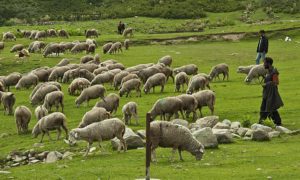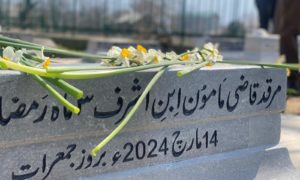Amid the competing pitches praising the new-age enterprises, the artistic legacy which empowered Kashmir after the faithful transition is fading and making its last inheritors like the map artist of Srinagar suffer in silence.
Before frown came fondness — engaging Mohammad Maqbool Jan in his home studio like a meditative sage. His musings reflect in his artistic strokes. The upshot of this devotion recently made him a celebrated case.
But then the buzz created by his fresh feat of putting Srinagar on the map ends the moment he delves deep into the whirlpool devouring the last vestiges of Kashmir’s iconic craft industry.
In his mid-fifties, Jan graces a vibrant workplace in his Srinagar Lal Bazar residence. The aura around him makes him a committed worker of yore. It’s with the same old promise that he mapped Srinagar and became of the resilient artists fighting the craft demise today.
Jan has been making the map of Srinagar for the last two years, but harboured a dream to create a showpiece since his teen years. The motive behind the masterpiece was to restore the fallen grace of Kashmir Art.
“And then,” he hastens to say, with a thoughtful pause, “the purpose of making the map was also to tell the present generation how important it’s to preserve our culture, tradition and architecture.”

Jan shows his masterpiece artwork that he has been working on since the last two years. [FPK Photo/Zainab.]
Jan comes from the clan of craftsmen who kept the benefactor saint’s skill legacy intact with their devotion since ages. But these cogs of the art-wheel assert that the handcraft is a painstaking emporium—fuelled by patience and time, and ends up crippling physical and mental state of artists.
With time, these hardships in league with the hostile situation have only hit Kashmir’s skill inheritance. But as one of the finest and award-winning Papier-mâché artist from Kashmir today, Jan thinks ‘out of the box’ to change what he calls the society’s make-believe idea of life.
“Apart from education,” he believes, “a person should have a technical skill for earning his livelihood.”
He makes a larger comment on the churning factory of unemployment created in the name of education in Kashmir.
After slogging for years and finishing their college and university degrees, thousands of youth find themselves at the crossroads of their careers in the valley.
With norms for government jobs getting tougher, Jan reckons, most of these youngsters are becoming wasted assets.
“This is where skills come to one’s rescue,” he maintains. “We need to read history to understand how skills helped us sustain during some terrible and treacherous times, before we decided to slam axe on our feet. But then, there’s always a room for introspection and revival.”

Jan spends most of his time by his work desk mixing colors and creating art. [FPK Photo/Zainab.]
However, it’s one thing to sound optimist and another thing to live like one amid the sullen state of affairs.
“We may be singing paeans of our art, but at the end of the day choosing handicraft as a profession is not considered a good job in Kashmir,” Jan rues.
“You get a peanut payment apart from the undesirable treatment from the society. I mean, who wants to marry their daughters with Kashmiri artisans these days? Such bitter realities are the telling comment on us and our delusional way of living.”
This has to change, the artist says.
“In fact, our attitude towards things has to change for good. We can’t go on lamenting over our plight forever without doing anything about it.”
Apart from being vocal about the craft condition, Jan has been working for its revival for years now.
He had ideas, he says, a lot of them — all aimed at stimulating the skilled hands of Kashmir. But there were hardly any takers, he rues: “In the heritage city of Srinagar, the loss of aesthetics and rise of market-bred mediocrity is leaving a narrow room for the native artisans who once made Srinagar a skill capital.”

Jan showing one of the finest of his artworks. [FPK Photo/Zainab.]
To play his part though, he approached the administration for training school and college students in Kashmir Art.
His gritty approach was approved and became the basis for the Kashmir Fabric Painting.
Under this project, he trained students in arts for over 20 years. He then started painting on suits and worked to improve Papier-mâché market. But the changing lifestyle and trends became barriers for him.
And since the Kashmir Art is yet to come under any degree or certificate course, the young generation doesn’t consider it as a career option, the artist says: “Our younger generation’s focus on digitalization and discouragement from their parents about skill-learning is also obscuring the art.”
Given the paucity of art-platforms, the artist says, the administration should hold workshops at the state-level to engage more and more people. “This is how kids will learn Kashmiri crafts and become skillful in life.”

Jan’s recent work is a fusion between Khatemband and Papier mache art. [FPK Photo/Zainab.]
But while Jan fights for the art revival, the curbs unleashed on his homeland since August 2019 have slowed him down.
In absence of the official helping hand, he says, his class has been left to survive on their own.
With the result, many artisans sold their craft at low prices to meet their daily expenses.
“I’m an award-winner but awards won’t feed my family,” he says.
“I had to sell my artwork and wife’s gold for survival and fulfilling demands like school fees of my children. Where we will go? No one is ready to help craftsmen of Kashmir. We’re losing our living as well as legacy.”
Free Press Kashmir is now on Telegram. Click here to Join.
FPK Android App for 2G. Click here to Download.








